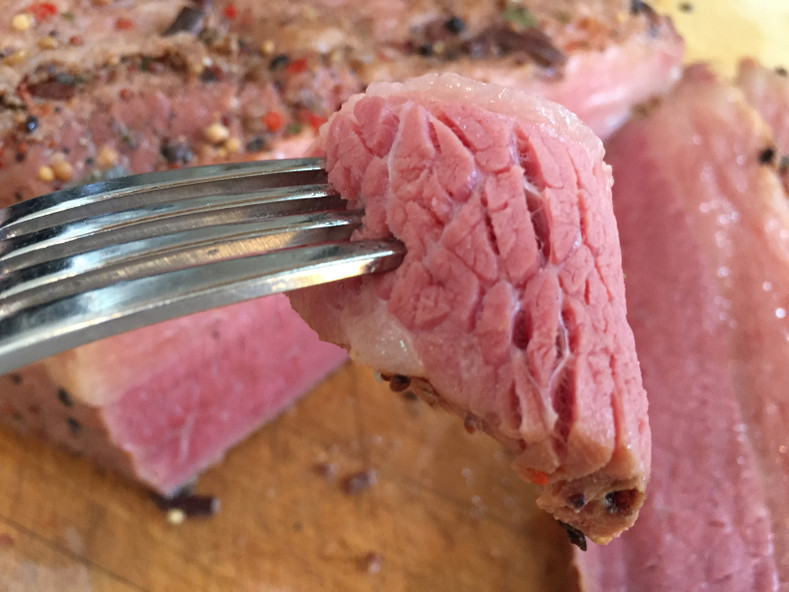How to Make Sous Vide Corned Beef for Tender, Flavorful Results

Despite its name, corned beef has nothing to do with corn, the vegetable. No, most culinary eggheads seem to agree that the “corned” in corned beef is directed by the size of the rock salt granules that were used to “corn” or preserve meats, back in the day. The word corn hailing from old English may also refer to the large size of the nitrates that were combined with the rock salt used to preserve the meat.
Nitrates and Nitrites have received a bad rap in the food industry lately. Granted too much of a good thing can kill ya, but the use of nitrates in corned beef, as well as other classics, cured meats are there for a reason and a good one. To stop botulism consequently, keeping humanity alive! Nowadays with quality refrigeration, it’s less of a necessity, but when you are curing a slab of brisket for a week before cooking for two and a half days itis good to know you have some help, better living through chemistry I like to say! Not to mention how much would you miss that lovely pink flesh on your Saint Patty Day’s brisket or the layer upon layer of savory pink corned beef on your Rueben? Yes, all of that and so much more you can attribute to nitrates.
An excellent pairing with this incredibly tender and full flavored beef is our sous vide version of Colcannon, and simple sous vide carrots. Regardless of your choice of sides this corned beef recipe is a winner and is so ridiculously simple and unbelievably tasty that I’m sure that it will become a regular on your menus!

Ingredients:
• 18 pounds’ brisket, whole
For the brine:
• 6-8 quarts’ water, tap
• 1 1/4 cups kosher salt
• 1/2 cup maple sugar
• 12 whole cloves
• 1 1/2 teaspoons black peppercorns
• 1 teaspoon allspice berries
• 2 teaspoons mustard seeds, light
• 2 teaspoons mustard seed, dark
• 4 large bay leaves
• 1 whole cinnamon stick, crumbled
• 1 teaspoon red pepper flakes
• 1/2 teaspoon ginger, ground
• 12 large garlic cloves, peeled and cracked
• 1 ounce pink curing salt
For the brisket rub:
• 24 whole cloves
• 1 tablespoon black peppercorns
• 2 teaspoons allspice berries
• 2 teaspoons mustard seeds, light
• 2 teaspoons mustard seed, dark
• 8 whole bay leaves
• 2 large cinnamon stick
• 2 teaspoons red pepper flakes
• 1 teaspoon ginger, ground

Directions:
For the brisket:
1. Using a sharp long bladed knife trim off any excessive fat on the brisket making sure you keep at least a 1/4 to 1/2 inch covering the meat.
2. Trim off any other hanging pieces of meat or fat and discard.
3. Optionally you may want to split the brisket in two for easier handling, packaging, and cooking.
For the brine:
1. In a large non-reactive lidded container, combine spices with garlic salt, sugar, and water.
2. Stir vigorously with a large spoon or whisk to combine well making sure that the salt and the maple sugar have completely dissolved in the water.
3. Submerge the trimmed brisket in the brine, cover and place it in the refrigerator for 7-10 days
For the corned beef rub:
1. In a small bowl, mix all ingredients for the rub together.
2. Using a mortar and pestle or food processor grind the ingredients together to a rough mixture.

For Cooking:
1. Remove brisket from the brine and pat dry with a towel.
2. Sprinkle the rub evenly over the meat and gently massage the spices into the meat
3. Preheat the VacMaster SV1 to 140 °F / 60 °C.
4. Using suitable sized VacMaster bag(s) and a VacMaster chamber or suction machine vacuum-seal the rubbed beef brisket
5. Gently place the vacuum-sealed brisket it the SV1
6. Monitor the water level to make sure the meat stays submerged.
7. Cook for 60 hours.
8. Remove the corned beef from the water bath and remove from the bag.
9. Portion the meat as necessary and serve immediately.

